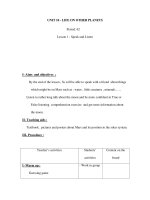life on a chicken farm
Bạn đang xem bản rút gọn của tài liệu. Xem và tải ngay bản đầy đủ của tài liệu tại đây (6.41 MB, 49 trang )
by Judy Wolfman
photographs by David Lorenz Winston
by Judy Wolfman
photographs by David Lorenz Winstonby Judy Wolfman
photographs by David Lorenz Winston
t Carolrhoda Books, Inc. / Minneapolis
Text copyright © 2004 by Judy Wolfman
Photographs copyright © 2004 by David Lorenz Winston
All rights reserved. International copyright secured. No part of this book may be
reproduced, stored in a retrieval system, or transmitted in any form or by any
means—electronic, mechanical, photocopying, recording, or otherwise—without
the prior written permission of Carolrhoda Books, Inc., except for the inclusion of
brief quotations in an acknowledged review.
Carolrhoda Books, Inc.
A division of Lerner Publishing Group
241 First Avenue North
Minneapolis, MN 55401 U.S.A.
Website address: www.lernerbooks.com
Library of Congress Cataloging-in-Publication Data
Wolfman, Judy.
Life on a chicken farm / by Judy Wolfman ; photographs by David Lorenz
Winston.
p. cm. — (Life on a farm)
Summary: A child explains the activities taking place at home on a working
chicken farm.
eISBN: 1–57505–770–0
1. Chickens—Juvenile literature. 2. Farm life—Juvenile literature.
[1. Chickens. 2. Farm life.] I. Title: Chicken farm. II. Winston, David Lorenz,
ill. III. Title.
SF487.5.W66 2004
636.5'13—dc21 2002152919
Manufactured in the United States of America
1 2 3 4 5 6 – DP – 09 08 07 06 05 04
We dedicate this book to the entire Martin family—Aaron, Emma Ruth, Loren, Jolene, Rosalyn,
Jadon, and Ethan. Our thanks and appreciation for the many hours they spent helping us develop
this book.
Also to the family of John H. Schwartz, Lancaster County Extension Director: We’re thankful for the
expert knowledge and advice John provided us about chickens. His contribution was invaluable.
—J.W. and D.L.W.
CHICKENS for Neighbors. . . . . . . . . . . . . 6
More Work to Do . . . . . . . . . . . . . . . . . 22
Good-bye Chickens—Hello Chicks . . . . 30
Fun Facts about Chickens . . . . . . . . . . 44
Learn More about Chickens . . . . . . . . . 45
Glossary . . . . . . . . . . . . . . . . . . . . . . . 46
Index . . . . . . . . . . . . . . . . . . . . . . . . . 47
About the Author and Photographer . . . 48
Contents
6
How would you like to live next door
to chickens? I live next to 95,000 of
them, and I love it! My name is Loren
Martin, and I live on a chicken farm
with my family. Besides Mom and Dad, I
have two sisters, Rosalyn and Jolene, and
two brothers, Jadon and Ethan. We like
working on the farm, because we do it as
I’m proud to work on my
family’s chicken farm.
a family. And we like chickens, because
they are fluffy and fun to take care of!
Our farm is called the Under His Wings
Farm. We raise only chickens, not geese,
ducks, or turkeys, like some poultry
farmers do. And we raise our chickens
for meat, not for eggs.
CHICKENS
for
Neighbors
7
Our family dog rests while we work hard raising chickens. The life of a dog!
8
It takes us eight weeks to raise a batch
of chickens. Then the chickens are
taken away, and we start raising a new
batch. In one year, we take care of five
batches of chickens—that’s 475,000
chickens!
When chicks first come to our farm, they look like little balls of fuzz—with small beaks and skinny legs!
Sometimes I can’t believe how many chickens
we take care of during the year. With all the
chickens we raise, we feed a lot of families.
9
10
When my family first bought the farm,
we didn’t know anything about raising
chickens. The man who sold the farm to
us was really helpful. He spent a whole
year teaching our family what to do. All
seven of us learned about chickens
together. At the end of the year, we were
ready to run the business ourselves.
My family and I like to be together. I’m on the far right.
11
We work just as hard
on our homework as
we do on our farm.
On a normal day, we get up between
5:00 and 5:30 in the morning. Then we
say our morning prayers until 6:00 in
the morning. After that, we start
school. But we don’t go to a regular
classroom—Mom teaches us our school
subjects at home. By going to school
here, we can do our daily chores in
between our studies. It’s a good thing,
because our farm gets pretty busy, espe-
cially when we get a batch of new
chicks, or baby chickens.
12
We raise chickens for a processing
plant, a place where chickens are made
into food. Before we get our chicks, work-
ers at the plant take care of them until
they hatch, or break out of their eggs.
The chicks are hatched in incubators.
An incubator is a machine that keeps
eggs warm, so chicks will grow. The eggs
stay in incubators for twenty-one days.
Then the chicks hatch, and it’s time for us
to start raising them.
Just before the chicks arrive, we look in the chicken houses one last time.
They have to be clean for our new chicks.
13
Once the delivery truck arrives,
we start unloading the chicks and
making them comfortable.
Workers from the plant deliver the
chicks to us when they are four to eight
hours old. The workers bring the chicks
to our three chicken houses. We have
two small houses and one big house.
Each one has two levels. They’re like big
apartment buildings for chickens.
14
The chicks come in boxes that are
stacked on a truck. Each box has about
100 little chicks in it. The truck drives
along the side of each chicken house.
We take the boxes off at doorways along
the way. When we get the boxes inside,
we gently tip them under brooders.
Brooders are metal dome-shaped covers
about 3 feet around. Heat comes down
through a hole in the middle, so the
chicks stay warm. About 800 chicks
huddle under each brooder.
A boxful of little chicks!
Mom places the new chicks under
the warm brooders.
After we dump the chicks, they’re a
little scared. They soon make lots
of high-pitched peeping sounds. After a
while, it gets very noisy. The chicks
scurry around and run toward any noise
they hear. Soon they settle down,
though, peeping a little bit every now
and again.
The chicks are used to high temperatures. Under the brooders, they seem to feel right at home.
15
16
You can barely see
the small combs on
these Cobbs.
The chicks are a straight run, a mix-
ture of girl and boy chicks. They are
slightly bigger than a golf ball. Their
bodies are covered with soft, yellow
fuzz, or down. Each chick has a tiny
comb, or fleshy red crest, on top of its
head, too.
When you first look at our chicks, they
all seem to look alike. But they vary in
size and have unique features, just like
people do. The chickens we raise are a
kind called Cobbs. Most are white when
full grown, but some have specks of
brown or black.
When the chicks first come to our farm,
we don’t have to feed them right away.
While a chick is in an egg, it gets food
through the yolk (the yellow part of the
egg). This food helps the chick stay
healthy for twenty-four hours after it
hatches. Then we start giving the chick
tiny pellets. These pellets are a mixture
of corn and soybean meal. The pellets
give the chick all the nutrition it needs.
17
Ethan cuddles up to a few little chicks.
Soon they will grow to be chickens.
We don’t know how many girl or boy
chickens we have until later, when boy
chickens’ combs get bigger.
I have to make sure the feeder flats are filled
with pellets. The chicks need food to grow.
We feed the chicks in the morning and
evening. We carry the pellets in 5-gallon
buckets. Then we dump them into feed-
er flats, or pans, under the brooders.
Feeder flats are small plastic trays that
the chicks can eat from. Each flat looks
like a big cookie sheet with sixteen sec-
tions and short sides. The sides keep the
food from being scratched out onto the
floor by the chicks.
18
19
After ten days, our jobs get easier. We
start to give the chicks bigger pellets
through an automatic feeder system.
This is how it works: We store pellets in
two outside feed bins. As the chicks eat,
the feed bins drop the pellets into a
pipeline. The pipeline takes the pellets to
another bin, called a feeder. The chicks
eat from this feeder. We just have to
make sure the feed bins are always full.
We also give the chicks water through
an automatic water system. Water runs
through another pipeline. This pipeline
is close to the ground, next to the brood-
ers. It has small nipples that drip water
when the chicks peck at them. The
chicks can drink as much, and as often,
as they want. As the chicks grow, we
raise the pipeline to make sure they can
reach the nipples.
We make sure the chicks always have enough food. It’s a good thing, because they can get very hungry!
20
It’s fun to watch the chicks get bigger.
When they are about ten days old, they
start to lose their yellow down. Now
feathers begin to appear all over their
bodies. By the time they’re fourteen
days old, chicks aren’t yellow anymore.
Their feathers may be white, black, or
brown, depending on the chicken.
Once they have their feathers, they’re
called chickens, not chicks.
Boy chickens are called roosters, and
girls are called hens. We can tell them
apart by their combs. Roosters usually
have larger and brighter combs than hens.
This growing chicken has feathers now!
21
To keep our chickens healthy, we put a vaccine
in the water. Chickens love water!
When the chickens are fourteen days
old, we give them a vaccine. This vac-
cine keeps our chickens from getting a
disease that can affect their breathing.
We give them the vaccine through the
water system. When a chicken drinks
the water, it also drinks the vaccine.
Vaccines help our chickens to keep grow-
ing strong.
Helping our chickens stay healthy is
more than just feeding them, giving
them water to drink, and keeping them
safe from diseases. The houses they live
in need care, too.
22
Dad and I do many jobs that help keep
the chicken houses healthy for our
chickens. One of our jobs is to make sure
the thermostats and fans are working
properly. A thermostat helps keep tem-
peratures the same throughout the day
and night. Fans help thermostats do their
jobs by removing heat from the chicken
houses. Temperature is really important
to a chicken’s health. It needs to be just
right, or our chickens could get sick.
We do a lot to
keep our chickens
healthy.
Work
More
to Do
I have to make sure the thermostat is doing its job.
These fans help
our chicken houses
to stay cool.
23
24
Dad and I also check the fogger sys-
tem. This system is used mostly in the
summer, when it’s very hot. It has a lot
of nozzles that spray a mist of water into
the air. The fans blow the mist and keep
the temperature cool. This way, the
chickens won’t get too hot. The fans
also keep fresh air flowing through the
chicken houses. Without fresh air, the
houses can get very stinky.
This nozzle sprays water that helps the chicken houses stay cool in the summer.









